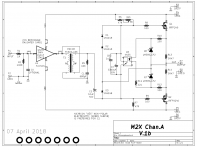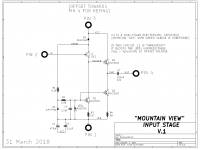There are transistors called 'chopper'.
For example JFET J111.
What is the caracteristics of chopper transistors?
Can such transistors be used in amplifiers?
For example use J111 as a current source.
For example JFET J111.
What is the caracteristics of chopper transistors?
Can such transistors be used in amplifiers?
For example use J111 as a current source.
The J111 is a common small signal JFET. If the word chopper is used in relation to those then it probably means suitable for chopper stabilised amps and so on.
To me a chopper transistor is a high voltage high current switching bjt or FET used as the main switching element in an SMPS. Older types were like BU326, BUT11.
The J111 is perfect for small signal stuff including current sources.
To me a chopper transistor is a high voltage high current switching bjt or FET used as the main switching element in an SMPS. Older types were like BU326, BUT11.
The J111 is perfect for small signal stuff including current sources.
Thanks.
I can buy J111 for a good price.
They are more cheap than some special JFETs, like 2SK170 and so.
I can buy J111 for a good price.
They are more cheap than some special JFETs, like 2SK170 and so.
Yes, but they are some of the few TO92 JFETs still available. Buy some extras now before they disappear too......They are more cheap than some special JFETs, like 2SK170 and so.

Thanks.
Especially useful is the cascading.
This makes the current source much more stable when the voltage changes.
Especially useful is the cascading.
This makes the current source much more stable when the voltage changes.
They were intended to be used as switches in peculiar applications, mainly for synchronous switching, but not exclusively.There are transistors called 'chopper'.
For example JFET J111.
What is the caracteristics of chopper transistors?
At an epoch when DC amplifiers had huge offsets and drift, direct amplification was not an option. The workaround was to chop the small DC input between GND and the actual value, using mechanical switches, photoresistors, FETs or anything suitable. The resulting squarewave having a p-t-p amplitude equal to that of the DC input could then be amplified and recovered easily, using means available at the time. Simpler schemes used asynchronous rectification (AKA diode), but better systems used synchronous rectification, which also eliminated random noise and narrowed the detection bandwidth without introducing complex filters and excessive time constants.
Choppers were used for thermocouples, photosensitive detectors, etc (and are still used today).
Choppers can also be used in muting applications, etc.
With traditional technological FETs tradeoffs, the low Ron resistance associated with the switching function normally results in large capacitances, making their use awkward for some applications, but more modern types have been largely (but not completely) freed of theses constraints
Certainly, if you take into account the above remarksCan such transistors be used in amplifiers?
For example use J111 as a current source.
Chopper amplifiers of the 60s with chopping done by BJT transistors were asking for Vsat as low as possible. A trick to achieve this was to reverse c and e of a transistor. A PNP stays a PNP with lower Vsat and lower gain.
Choppers were used to implement Op amp to actually do analog computation.
Search for Edwin A. Goldberg patent 1949 drift stabilization. Firstly done with tubes and later with bipolar transistors.
This makes me think that a chopper transistor is a transistor optimized for low Vsat. May be I am wrong and this is just a naming coincidence
Choppers were used to implement Op amp to actually do analog computation.
Search for Edwin A. Goldberg patent 1949 drift stabilization. Firstly done with tubes and later with bipolar transistors.
This makes me think that a chopper transistor is a transistor optimized for low Vsat. May be I am wrong and this is just a naming coincidence
I'm using the J112 N-channel JFET in the input stage of a power amp, specifically in the M2x "Mountain View". The J112 is a chopper JFET, the big bold title on its datasheet says N channel switch yet it works really well in the amplifier application I've chosen. For what it's worth.
Calling them (DC signal) choppers is the Marketing Dept. buzzword to avoid calling them "cheap and nasty".There are transistors called 'chopper'.
For example JFET J111.
What is the caracteristics of chopper transistors?
Can such transistors be used in amplifiers?
For example use J111 as a current source.
FETs have incredible manufacturing spread, are all over the place, so the best are suitable for amplification (AF and RF) and the worst are "only suitable as choppers"
Typically they have high Vp , pinchoff(cutoff) voltage on the order of 4 or 5V , which makes them hard to bias as amplifiers but no big deal if used as audio switches, current sources and .... um ..... choppers ..... so they are suitable for your task.
As amplifiers they need high (wasteful) bias voltage, but worse is they have very poor Transconductance at low currents typical in gain stages (say around 1 mA) so they have poor audio gain.
Yet you may get a few good ones , a few pearls among the mud.
I make Guitar amplifiers, so I buy available FETs by the 100 and measure them.
The ones with the lower bias voltage go for preamp duty as gain stages, the mid ones are used as "cathode followers" and the worst are used for channel, reverb and loop switching .... nothing gets wasted.
There are a few FET matchers out there, this is the one I use.
With values shown it´s set to test Power Mosfets to match/balance them when used in Power amplifiers, but the very same setup, using a 10k to 15k resistor instead , gives you "voltage needed to pass 1mA" or thereabouts, which is fine for preamp stages.
An externally hosted image should be here but it was not working when we last tested it.
EDIT: important detail: manufacturers do not test them one by one but batch samples, they call the worst J111 , somewhat better ones J112 and "best" J113 so if you have a choice go for the higher numbers.
Still all over the place, but you start with a better bulk preselection.
Last edited:
Chopper amplifiers of the 60s with chopping done by BJT transistors were asking for Vsat as low as possible.
... This makes me think that a chopper transistor is a transistor optimized for low Vsat. ...
FETs have "zero" Vsat. The channel is all one lump. A BJT switch is two junctions and "low VceSat" requires getting both to the same voltage. Reverse mode is one trick.
As JM and others are saying, "the feature" of a "switch" JFET is _high_ threshold voltage. The turn-on/off change should be larger than the signal being switched, or the signal will modulate the channel conductance. This happens to work out also because a high Vto part is often a low R part.
Conversely for high Voltage Gain we want a _low_ Vto. We get the maximum output swing by wobbling the gate almost Vto volts. Low Vto tends to high gain.
So raw-baked JFETs, ranging from soft to crunchy depending on mix and oven variations, naturally sort into "switches" and "amplifiers". If you have a complete range of parts, you want to go with this sorting philosophy. However today our choices are limited. We can work with the "non-optimum" parts, but maybe more thinking and/or less performance.
I don't think so. I think the most important characteristic of an analog switch JFET is its on-to-off ratio. That's why the datasheet spec "Id_off = 1.0 nA max" is featured ... so you can compare it against "Idss = 20 mA min" to discover that the on-to-off ratio is a minimum of 20 million for the J111. If you're make a 2-to-1 mux out of these JFETs then the channel-to-channel crosstalk is better than -146dB. A nice comforting number.
Plunk a J111 or, even better, a J105 on a curve tracer. You'll see exactly what they sacrificed to make a device that turns ON very hard and turns OFF even harder.
Plunk a J111 or, even better, a J105 on a curve tracer. You'll see exactly what they sacrificed to make a device that turns ON very hard and turns OFF even harder.
Speed and rejection of the control voltage is important in Sample and Hold applications.
I remember this was a blessing when came good devices like the AM1000, I had an application where rejection of control voltage was extremely important. Frequency synthesizers where the phase noise requirement was extremely tough with the available technology of that time.
AM1000: Silicon N channel high speed analog switch
https://4donline.ihs.com/images/Vip...7-1.pdf?hkey=EF798316E3902B6ED9A73243A3159BB0
May be this was a chopper transistor before that name got invented.
I remember this was a blessing when came good devices like the AM1000, I had an application where rejection of control voltage was extremely important. Frequency synthesizers where the phase noise requirement was extremely tough with the available technology of that time.
AM1000: Silicon N channel high speed analog switch
https://4donline.ihs.com/images/Vip...7-1.pdf?hkey=EF798316E3902B6ED9A73243A3159BB0
May be this was a chopper transistor before that name got invented.
...I think the most important characteristic of an analog switch JFET is its on-to-off ratio.....
There are MANY applications for "analog switches". On-to-off is critical for some, indifferent for others. "Choppers" can be made to work well-enough with quite crummy switches. mchambin's "speed" is uncritical in some choppers since the alternative was a 60Hz relay chopper.
Last edited:
Analog mux: Many applications, indeed and wacky designs when used in digital circuitry. I have debugged and fixed a lot of digital stuff where "designers" had been using ALL circuits of the data book. Guys who had no idea about fan in, fan out.
Figure 1 below is the First Watt M2 power amplifier, designed by Nelson Pass. Notice that it is a Class-A circuit with no feedback.
Figure 2 below is the (removable) input stage of the amplifier, using a Chopper Transistor (J112), designed by me. Notice that it is a Class-A circuit, single ended, with no feedback.
I have also attached the datasheet of the J112 chopper transistor.
_
Figure 2 below is the (removable) input stage of the amplifier, using a Chopper Transistor (J112), designed by me. Notice that it is a Class-A circuit, single ended, with no feedback.
I have also attached the datasheet of the J112 chopper transistor.
_
Attachments
- Status
- Not open for further replies.
- Home
- Amplifiers
- Solid State
- Can a Chopper transistor be used for amplifiers?


